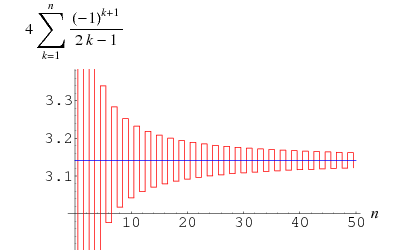El_Machinae said:
But isn't the foundation of pi and trig based on measurements?
I know we almost have a formula for pi, but how do we know that formula is correct past the sig digs? Just like we have a formula for the acceleration of gravity, but we learned later that we needed a more precise formula to explain more experiments.
What Pboily said. We don't almost have a formula for pi, we do have many formulas for pi, and for trig functions, that are not measurement based. As mdwh said, getting an exact value for the ratio of a square's perimeter to its side length is easy, and can be done without resorting to measurements. Same for pi, it's just the maths is slightly more complicated.
You really don't need that much maths to know more about this though. One of the simplest way to work things out, that doesn't involve nasty looking calculations, is to draw a square inside and outside a circle.
2*pi*r is the circumference of the circle, that must be bigger than the inside square, smaller than the outside square. Basic pythagoras theorem will give you the perimeter of the squares in terms of r. Inside square is 4sqrt(2)r, outside square is 8r. Which makes pi between 2sqrt(2) (2.828) and 4.
Make the square an octagon, and you get a better approximation. Use the half-angle formula, and you get the new perimeters in terms of r. Double the side length two more times, to 32, and you have a reasonable approximation of pi, without even needing to resort to (or invent) a calculator or a measurement.
Actually, writing this down it's probably easier to start with a hexagon, double it three times to 48 sides, and you have pi to 3 sig figs. (3.13935<pi<3.14609)
With just yr 10 trig and a calculator, you can write a general formula. Use 2 regular polygons with n sides, one inside, one outside. The inside one can be split into n isosceles triangles, with side lengths of r, r, x, and an angle of 2pi/n at the centre (360/n if you use degrees). Call this angle a. Cos rule says x^2=r^2 + r^2 - 2*r*r*cos (a). So x = sqrt(2)*r*sqrt(1-cos(a)), the perimeter is x*n, and you have a lower bound for pi of x*n/2r.
Do the same to the outside n-gon, this time you have n triangles, with the same angle in the centre, a height of pi, a base of y. You have a right angled triangle with side length y/2 & r, angle of a/2, so basic trig says tan (a/2) = (y/2)/r. y=2*r*tan (a/2), the perimeter is y*n, and you have an upper bound for pi of y*n/2r.
Plug in the biggest value of n you want to calculate things for (48 or 96 with pen & paper, using 10 million on your calculator will give you 12 sig figs), and you can as accurate a value for pi as you want. The stuff above looks complicated, but that's only because I'm forced to type it out, I can't draw a diagram and write the equation out nicely for you. It's really easy to do, anyone who knows cos rule for working out a triangle's side length given 2 sides and the enclosed angle is capable of doing this and deriving their own equation for pi, which they can then calculate themselves. I'd happily give it to a year 10 student as an assignment.



 to El Mac, IMHO.
to El Mac, IMHO.